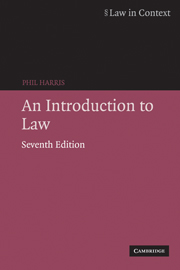Book contents
- Frontmatter
- Contents
- Preface
- Table of statutes
- Table of cases
- 1 Law and society
- 2 Law and morality
- 3 Law and the regulation of economic activity
- 4 Some important legal concepts
- 5 Law and property
- 6 Law and the settlement of disputes
- 7 The making of legal rules
- 8 The European dimension of English law
- 9 Liability in English law: the law of tort
- 10 Liability in English law: crime and the criminal justice system
- 11 The development and the role of the contract
- 12 Law and government
- 13 The legal profession
- 14 The judges
- Index
10 - Liability in English law: crime and the criminal justice system
- Frontmatter
- Contents
- Preface
- Table of statutes
- Table of cases
- 1 Law and society
- 2 Law and morality
- 3 Law and the regulation of economic activity
- 4 Some important legal concepts
- 5 Law and property
- 6 Law and the settlement of disputes
- 7 The making of legal rules
- 8 The European dimension of English law
- 9 Liability in English law: the law of tort
- 10 Liability in English law: crime and the criminal justice system
- 11 The development and the role of the contract
- 12 Law and government
- 13 The legal profession
- 14 The judges
- Index
Summary
We have seen, at various points in this book, the ways in which certain activities and values come to be incorporated into law; such incorporation may be positive, as where the law is used to protect specific interests and values, or negative, as where the law, especially the criminal law, is used to proscribe certain activities because they offend certain dominant values (such as the sanctity of private property or the values attaching to particular moral beliefs), or because they are seen as an affront to the very foundations of social existence (such activities would include murder, rape and other violent behaviour). Definitions of ‘deviant behaviour’, then, are not something ‘pre-social’, that is, eternal, permanent and deriving from periods prior to social life as we know it; rather, they are dependent upon particular social structural arrangements at given periods of history. Whatever the origins of particular legal rules proscribing ‘unacceptable’ behaviour may be, those legal rules do have certain things in common, one of the most important of which is that they invariably provide for some form of legal sanction to be visited upon the offender upon conviction by a court.
- Type
- Chapter
- Information
- An Introduction to Law , pp. 306 - 348Publisher: Cambridge University PressPrint publication year: 2006



